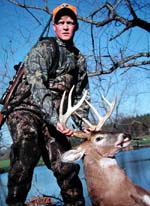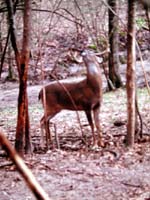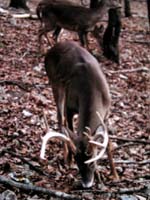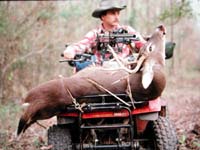
|
Features
|
|
|
|
Books
|
|
|
|
Fun & Games
|
|
|
|
Contact Us
|
|
|
John's Journal... Entry 128, Day 3
SECRETS OF DEER-HUNTING GUIDES
Walker's Tips For Taking Monster Bucks
 EDITOR'S
NOTE: For some, deer hunting isn't just an
annual event, it's their livelihood. When they talk, you'd do well to
pay attention. A professional deer-hunting guide earns his living by finding
bucks for his clients every season. These avid woodsmen have spent their
lifetimes studying the habits and haunts of deer. They experience consistent
success because they know more and hunt more than the average outdoorsman.
True masters of the sport of deer hunting, deer-hunting guides have developed
common-sense tactics that will produce bucks for you anywhere you live.
EDITOR'S
NOTE: For some, deer hunting isn't just an
annual event, it's their livelihood. When they talk, you'd do well to
pay attention. A professional deer-hunting guide earns his living by finding
bucks for his clients every season. These avid woodsmen have spent their
lifetimes studying the habits and haunts of deer. They experience consistent
success because they know more and hunt more than the average outdoorsman.
True masters of the sport of deer hunting, deer-hunting guides have developed
common-sense tactics that will produce bucks for you anywhere you live.
BOB WALKER - Like Norton, Bob Walker hails from the Black Belt area around Livingston, Alabama, and has hunted deer all his life. Walker guides at Bent Creek Lodge near Jachin, Alabama, but employs tactics completely different from Norton's to find and take trophy bucks.
 STRATEGY
ONE - "I believe in long-range hunting," Walker says. "To
take a trophy buck, you must see him. I like to hunt powerline right-of-ways
and old abandoned woods roads or logging roads where I can see 200 to
300 yards with my binoculars. When I scout these open areas, I look for
two things -- well-used trails, where deer cross these open regions and
tracks. I've found that most of the time trophy bucks won't walk across
open areas most other deer will walk. Also they rarely will walk across
an opening in the same place regularly.
STRATEGY
ONE - "I believe in long-range hunting," Walker says. "To
take a trophy buck, you must see him. I like to hunt powerline right-of-ways
and old abandoned woods roads or logging roads where I can see 200 to
300 yards with my binoculars. When I scout these open areas, I look for
two things -- well-used trails, where deer cross these open regions and
tracks. I've found that most of the time trophy bucks won't walk across
open areas most other deer will walk. Also they rarely will walk across
an opening in the same place regularly.
"I search for big, wide, deer tracks - after considering how wet the ground is and then determining whether or not the buck was running when he made the track. These two factors - wet ground and the deer's running -- often will make a track appear larger than it actually is. Once I find these types of tracks, then I'll take a stand along the right-of-way or the road in hopes of seeing the deer. I sight my gun in at long range and spend plenty of time on the range. Then I know I can shoot accurately at that distance. If I see the buck in these wide-open spaces, I'm convinced I can take him."
 STRATEGY
TWO - "I hunt rainy days, though most people don't hunt them,"
Walker emphasizes. "I've learned you often can spot and bag more
bucks on rainy days than at any other time. Most rainsuits make too much
noise, so unless the weather is very cold, I don't wear a rainsuit. I
choose to get wet instead. If the weather turns cold, and I feel I have
to wear a rainsuit, I put on my hunting clothes, next my rainsuit and
then a cotton shirt and pants of Mossy Oak camouflage on top of the rainsuit.
Wearing that soft, camouflaged clothing on the outside makes the rainsuit
much quieter. When the rain comes down hard, I'll stalk in cedar and pine
thickets where the deer hold to dodge the bad weather. As soon as the
rain stops or begins to slack off, I'll go to the edges of these thickets
and look for deer coming out of the thick cover and moving into the open
spots where they can get drier quicker."
STRATEGY
TWO - "I hunt rainy days, though most people don't hunt them,"
Walker emphasizes. "I've learned you often can spot and bag more
bucks on rainy days than at any other time. Most rainsuits make too much
noise, so unless the weather is very cold, I don't wear a rainsuit. I
choose to get wet instead. If the weather turns cold, and I feel I have
to wear a rainsuit, I put on my hunting clothes, next my rainsuit and
then a cotton shirt and pants of Mossy Oak camouflage on top of the rainsuit.
Wearing that soft, camouflaged clothing on the outside makes the rainsuit
much quieter. When the rain comes down hard, I'll stalk in cedar and pine
thickets where the deer hold to dodge the bad weather. As soon as the
rain stops or begins to slack off, I'll go to the edges of these thickets
and look for deer coming out of the thick cover and moving into the open
spots where they can get drier quicker."
Walker owns his own venison-processing plant and specializes in custom cuts of meat like venison filet mignon, meatloaf mixture and other delicious-tasting venison dishes. To learn more, call Walker at (205) 652-2489; (205) 652-7280.
 To
learn more tips for taking deer, go to Night Hawk Publications' home page
and click on books.
To
learn more tips for taking deer, go to Night Hawk Publications' home page
and click on books.
TOMORROW: BAD-WEATHER DEER-HUNTING TACTICS
Check back each day this week for more about Canadian Black Bears ...
Day 1 - Locating Big Bucks
Day 2 - More Strategies for Finding and Taking
Bucks
Day 3 - Walker's Tips For Taking Monster
Bucks
Day 4 - Bad-Weather Deer-Hunting Tactics
Day 5 - Pitman Consistently Takes Bucks